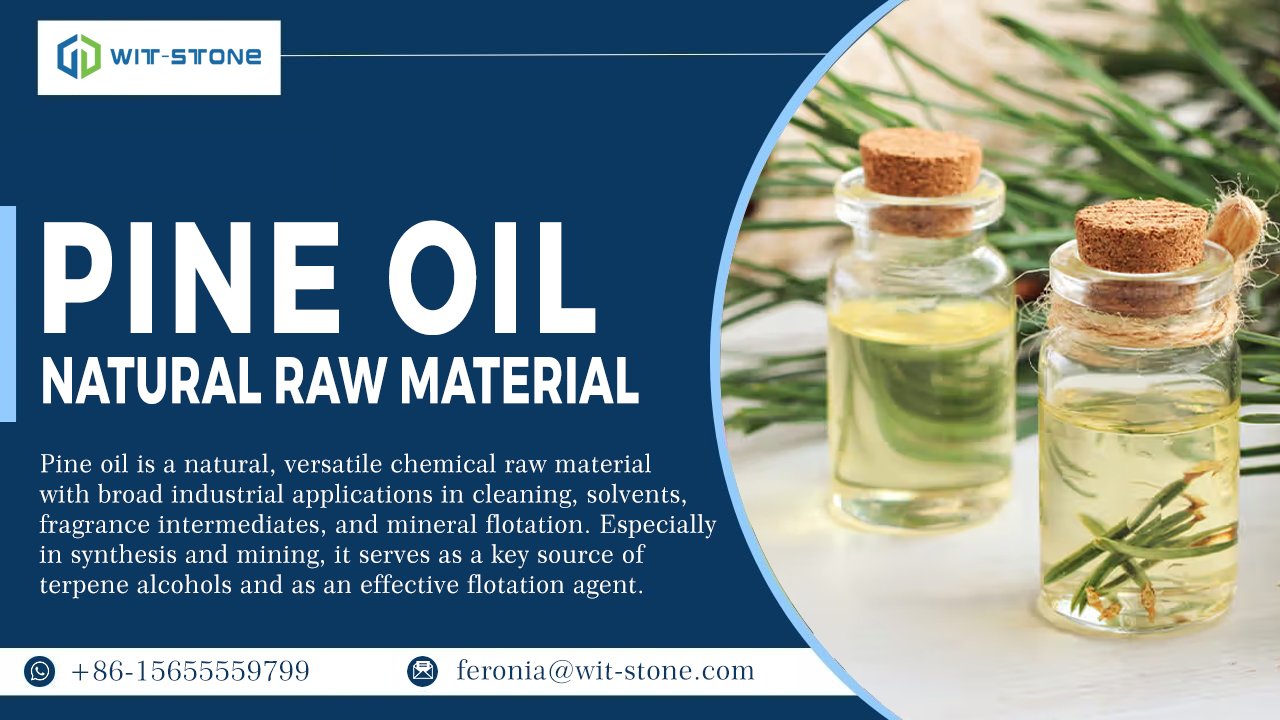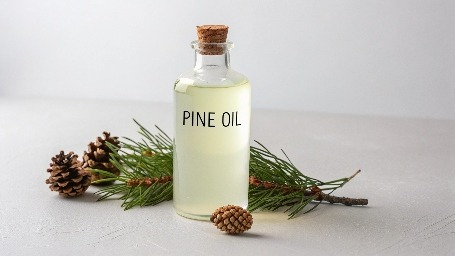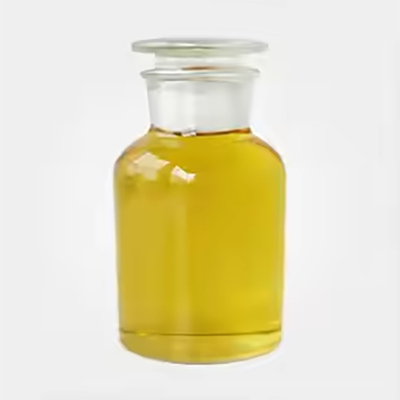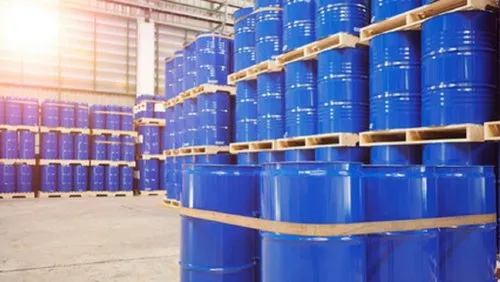Natural and Versatile Chemical Raw Material — Pine Oil

Catalog
🔍 1. Introduction to Pine Oil
Pine oil is a terpene alcohol mixture extracted from parts of pine trees—typically Scots pine (Pinus sylvestris)—including needles, branches, sawdust, and trunks through steam distillation. Its primary components include α-terpineol, β-terpineol, and other cyclic terpene phenols and olefins. Pine oil is typically graded into 50%, 65%, 70%, and 85%, indicating the percentage of terpene alcohol content. Higher grades offer increased purity, stronger fragrance, and enhanced disinfecting performance.
Pine oil differs from turpentine: although both originate from pine resin, pine oil consists of terpene alcohols, not volatile oils obtained via distillation and fractionation.

⚗️ 2. Chemical Properties and Functional Characteristics of Pine Oil
Strong solvency: Effectively dissolves oils, resins, and gums—serves as a natural organic solvent.
Excellent penetration: Penetrates surfaces and generates foam, aiding in cleaning and dispersion.
Broad-spectrum antibacterial and disinfectant properties: Effective against many Gram-positive/negative bacteria and enveloped viruses, though less effective on spores and non-enveloped viruses.
Pleasant fragrance: Pinewood aroma provides a natural deodorizing effect.
Limited water solubility: Soluble in alcohol and organic solvents.
These attributes make pine oil highly valuable across diverse industrial environments.

🏭 3. Industrial Applications Overview
🧼 3.1 Cleaning and Disinfecting Products
In the industrial cleaning sector, pine oil is widely used in products such as:
Floor and surface disinfectants for factories and workshops
Sanitizing agents in food processing environments for floors and kitchen equipment
Surface disinfectants in healthcare and medical institutions
Its natural antibacterial properties and strong penetration make it a superior alternative to many synthetic cleaning agents.
🎨 3.2 Paints, Inks, and Adhesive Solvents
In the coatings and ink industry, pine oil plays multiple roles:
As a solvent for premium inks and coatings, improving rheological and application performance
As a co-solvent for varnishes and organic finishes, imparting fragrance and mild antibacterial effects
In the rubber and plastics industry for adhesives, resin additives, and process coatings
Its moderate evaporation rate and solvent compatibility make it ideal for optimized industrial formulations.

🧪 4. Applications in Industrial Synthesis
🌺 4.1 Terpene-Based Intermediates in Aroma Chemicals
Pine oil serves as a raw material for the synthesis of fragrance compounds such as α-terpineol, geraniol, and linalool. These terpene alcohols are obtained via fractionation or catalytic transformation and are widely used in industrial production of perfumes and cosmetic bases. For example:
α-terpineol is utilized in perfumery and fragrance formulations
Linalool and geraniol are used in more complex essential oil and fragrance production
Pine oil is also involved in producing specialty resins, polymer precursors, and functional intermediates.
🧱 4.2 Water Treatment and Mining Chemicals
Pine oil has notable significance in mining, particularly in ore beneficiation and metal extraction:
Frother agent: A key reagent in mineral flotation, especially for sulfide copper ores. It promotes the formation of stable foam layers that facilitate the flotation and separation of target minerals.
Effective in low-concentration slurry flotation processes—enhances recovery rates for copper, zinc, and other sulfide minerals
Often used in combination with other surfactants or modifiers to optimize flotation efficiency and foam stability
🧴 4.3 Other Industrial Applications
Removal of pine resin or resinous buildup (e.g., in painting workshops or machinery)
As a plasticizer or resin solvent in rubber and plastics production
Used as a natural fragrance and auxiliary agent in specialty industrial formulations

⚒️ 5. Case Study: Pine Oil in Mining
In copper ore flotation, pine oil is commonly used as a frother in conjunction with collectors. Its mechanisms include:
Generating persistent and fine bubbles in slurry
Creating hydrophilic/hydrophobic interface differences, allowing sulfide mineral particles to adhere and rise with the foam
Maintaining a stable foam layer, facilitating subsequent mineral collection and filtration
This method is particularly effective in processing low-grade ore or slurries with lower solid content. Pine oil-based flotation agents remain widely used in copper mines worldwide.

📊 6. Comparative Analysis: Industrial Synthesis vs. Mining
| Application Area | Functional Role | Advantages |
|---|---|---|
| Industrial Cleaning & Hygiene | Cleaning, disinfecting, deodorizing | Natural antibacterial, mild, aromatic |
| Paints, Inks & Adhesives | Solvent, performance enhancer | Improves flow, lowers VOC, eco-friendly |
| Fragrance Intermediates | α-terpineol and other compounds | Natural terpene source, suitable for aroma industry |
| Mining (e.g., Copper Flotation) | Frother/flotation reagent | High flotation efficiency, stable bubble formation |

🏗️ 7. Extraction Process & Specifications
Pine oil is typically extracted via steam distillation, though solvent extraction and microwave-assisted extraction (MAE) are also used to improve yield and purity.
Commercial products are graded by terpene alcohol content (50%, 65%, 85%, etc.)
Typical Physical Properties:
Relative density: 0.885–0.927 g/mL
Boiling range: approx. 170–230 °C
Moisture content: ≤0.5–1%
Terpene alcohol content: 50–85%
Packaging: Usually supplied in 200 kg galvanized drums or ISO Tank/IBC containers—compatible with bulk export logistics and international shipping standards.

🧷 8. Practical Recommendations for Industrial & Mining Use
Product Selection: For mining, high terpene alcohol grades (65–85%) are recommended to ensure foam quality and mineral recovery. For coatings or cleaning agents, lower grades (50%) may suffice depending on cost-performance balance.
Formulation Compatibility: In flotation systems, combine with collectors and other frothers. In coatings, assess pine oil’s compatibility with resins and VOC targets.
Safe Handling: Pine oil is flammable and volatile. Store in cool, ventilated areas away from fire. Use appropriate PPE during handling to avoid inhalation or skin contact.
Export Compliance: Packaging and labeling must meet international regulations (e.g., UN2810 classification), including transport labels and documentation.

📝 9. Conclusion
Pine oil is a natural, versatile chemical raw material with broad industrial applications in cleaning, solvents, fragrance intermediates, and mineral flotation. Especially in synthesis and mining, it serves as a key source of terpene alcohols and as an effective flotation agent. For exporters, positioning pine oil as a multifunctional, eco-friendly raw material tailored to mining plants, chemical manufacturers, and coating producers can enhance competitiveness in global markets. Offering various grades while highlighting its environmental and safety advantages will help meet diverse industrial needs.
You can place an order or ask any questions, please feel free to contact at feronia@wit-stone.com | +86-15655559799



